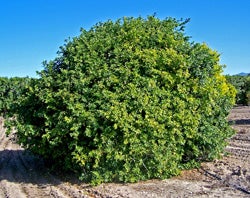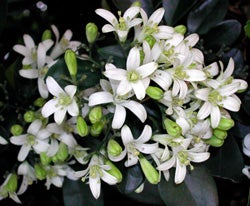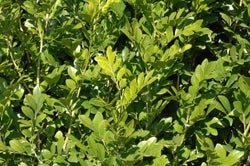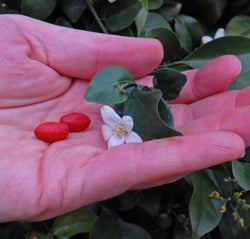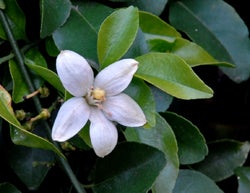Orange jessamine
Orange jasmine
Hawaiian mock orange
CRC 1637
PI 539746
Source
Received as a live plant from W.T. Swingle, Date Garden, Indio, CA, 1926.
Parentage/origins
Parents unknown
Rootstocks of accession
Own roots
Season of ripeness at Riverside
May to June
Season of flowering at Riverside
February to November
Notes and observations
Plants brought over from Indio by Roy Nixon.
EMN, 12/22/1987: An attractive compact shrub or small tree. Small green fruits present.
EMN, 1/20/1989: Most blossoms fell without setting fruit. Fruit is about the size of a pencil eraser at maturity, bright orange-red. Sweet flavor but not particularly palatible.
Description from The Citrus Industry Vol. 1 (1967)
"Kurz (1877, vol. 1, p. 190) described this species as follows: "An evergreen tree, 15-25 ft. [4.6-7.6 m] high, trunk 6-8 ft. [1.8-2.4 m] high, 1 1/2-2 ft. [46-61 cm] diam., the young shoots puberulous; leaves unpaired-pinnate or occasionally pinnately 3-foliolate, glossy, glabrous, or sometimes the rachis puberulous; leaflets alternate, cuneate-obovate or almost obliquely rhomboid, shortly petioluled, blunt or bluntish acuminate, 1-1 l/2 in. [2.5-3.8 cm] long, coriaceous; flowers rather large, white, in dense but small, almost sessile terminal corymbs; petals about 1/2-3/4 in. [13-18 mm] long, recurved; stamens 10, alternately shorter; ovary 2-celled, the style long with a capitate glandular stigma; berries ovoid-oblong, bluntish acuminate, nearly 1/2 in. [13 mm] long, orange-coloured, 1-2-seeded; seeds villous."
This species is very widely distributed and doubtless extremely old. However, it has evolved at a very slow rate, as is shown by the small morphologic differences that distinguish it from var. ovatifoliolata (noted below), which has been separated from the other forms of the species for many millions of years ever since Australia lost all land connections in the Eocene period. The wood of this species—particularly that of the roots—is much valued by the Malays for making kris handles, Burkill (1935, vol. 2, p. 1507) noted that the trunks split unless carefully seasoned and that few pieces are larger than 8 inches (20 cm) in diameter.
The orange jessamine is a handsome greenhouse ornamental that blooms profusely. It has large white fragrant flowers that are succeeded by small red fruits . In warm subtropical climates it thrives out of doors. It grows vigorously and can be propagated easily from cuttings. Citrus cannot as a rule be grafted on it, although one strain of lemon (an unidentified seedling) made a good growth on it in the greenhouses of the former Bureau of Plant Industry at Washington, D.C. There are many varieties and strains of M. paniculata in the Old World; possibly some of them would support Citrus better than the strain now grown in the United States, probably originally introduced from India.
Availability
Not commercially available through the Citrus Clonal Protection Program. Please check with your local nursery.
USDA Germplasm Resources Information Network page for Murraya paniculata

